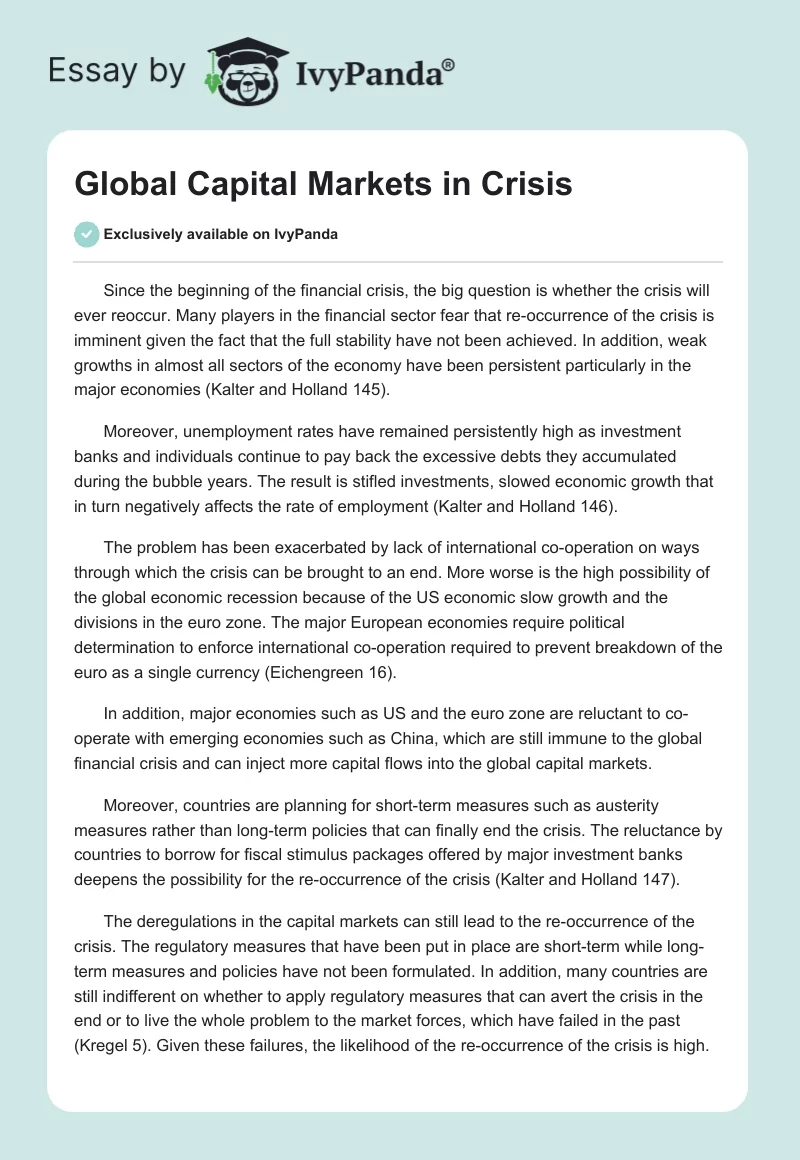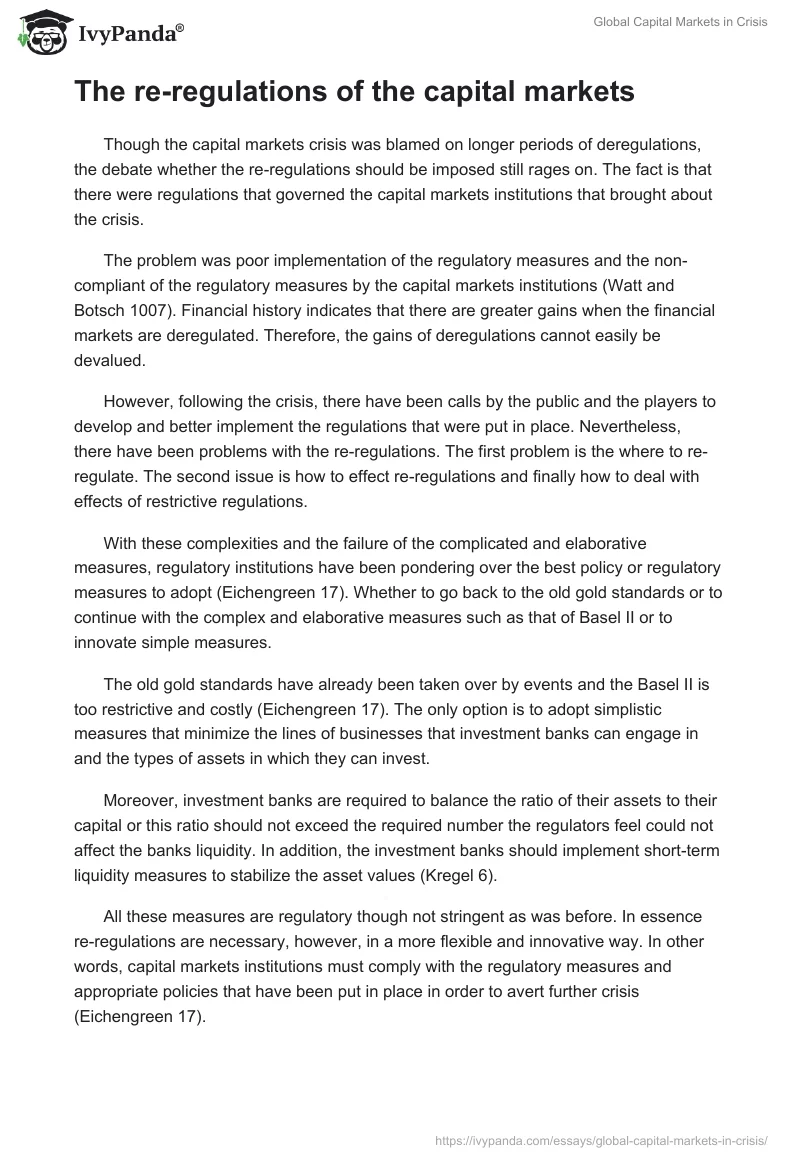Since the beginning of the financial crisis, the big question is whether the crisis will ever reoccur. Many players in the financial sector fear that re-occurrence of the crisis is imminent given the fact that the full stability have not been achieved. In addition, weak growths in almost all sectors of the economy have been persistent particularly in the major economies (Kalter and Holland 145).
Moreover, unemployment rates have remained persistently high as investment banks and individuals continue to pay back the excessive debts they accumulated during the bubble years. The result is stifled investments, slowed economic growth that in turn negatively affects the rate of employment (Kalter and Holland 146).
The problem has been exacerbated by lack of international co-operation on ways through which the crisis can be brought to an end. More worse is the high possibility of the global economic recession because of the US economic slow growth and the divisions in the euro zone. The major European economies require political determination to enforce international co-operation required to prevent breakdown of the euro as a single currency (Eichengreen 16).
In addition, major economies such as US and the euro zone are reluctant to co-operate with emerging economies such as China, which are still immune to the global financial crisis and can inject more capital flows into the global capital markets.
Moreover, countries are planning for short-term measures such as austerity measures rather than long-term policies that can finally end the crisis. The reluctance by countries to borrow for fiscal stimulus packages offered by major investment banks deepens the possibility for the re-occurrence of the crisis (Kalter and Holland 147).
The deregulations in the capital markets can still lead to the re-occurrence of the crisis. The regulatory measures that have been put in place are short-term while long-term measures and policies have not been formulated. In addition, many countries are still indifferent on whether to apply regulatory measures that can avert the crisis in the end or to live the whole problem to the market forces, which have failed in the past (Kregel 5). Given these failures, the likelihood of the re-occurrence of the crisis is high.
The re-regulations of the capital markets
Though the capital markets crisis was blamed on longer periods of deregulations, the debate whether the re-regulations should be imposed still rages on. The fact is that there were regulations that governed the capital markets institutions that brought about the crisis.
The problem was poor implementation of the regulatory measures and the non-compliant of the regulatory measures by the capital markets institutions (Watt and Botsch 1007). Financial history indicates that there are greater gains when the financial markets are deregulated. Therefore, the gains of deregulations cannot easily be devalued.
However, following the crisis, there have been calls by the public and the players to develop and better implement the regulations that were put in place. Nevertheless, there have been problems with the re-regulations. The first problem is the where to re-regulate. The second issue is how to effect re-regulations and finally how to deal with effects of restrictive regulations.
With these complexities and the failure of the complicated and elaborative measures, regulatory institutions have been pondering over the best policy or regulatory measures to adopt (Eichengreen 17). Whether to go back to the old gold standards or to continue with the complex and elaborative measures such as that of Basel II or to innovate simple measures.
The old gold standards have already been taken over by events and the Basel II is too restrictive and costly (Eichengreen 17). The only option is to adopt simplistic measures that minimize the lines of businesses that investment banks can engage in and the types of assets in which they can invest.
Moreover, investment banks are required to balance the ratio of their assets to their capital or this ratio should not exceed the required number the regulators feel could not affect the banks liquidity. In addition, the investment banks should implement short-term liquidity measures to stabilize the asset values (Kregel 6).
All these measures are regulatory though not stringent as was before. In essence re-regulations are necessary, however, in a more flexible and innovative way. In other words, capital markets institutions must comply with the regulatory measures and appropriate policies that have been put in place in order to avert further crisis (Eichengreen 17).
The future of Eurocurrency and Eurobonds
The Eurocurrency has expanded enormously in the past two decades because of many factors. The growth was due to the belief that the currencies can earn more interest in other countries as opposed to being deposited in the domestic banks.
In addition, the US regulations policy that discouraged lending to the non-US nationals encourage investors to borrow outside the US thus enhancing the growth of Eurodollars market (Watt and Botsch 1014). Another factor is the oil crises in the 1970s that led to the increase of dollars within the London banks enabling the Eurodollar market to expand considerably.
Due to its un-regulatory operations by any governments, the Eurocurrency market has remained attractive to many investors as banks can charge higher interest rates on deposits of the Eurocurrency compared to home currency and lower interest rates to any borrowers of the Eurocurrency as compared to the home currency. Further, the interest rate spread between the Eurocurrency deposits and lending is less as compare to that of domestic lending and deposit rates. As a result, the Eurocurrency banks become more competitive over the domestic banks (Watt and Botsch 1005).
Eurobond market also lacks regulatory interference thereby reducing the cost of issuing the bonds. In addition, Eurobond markets have less disclosure requirements saving the cost and time as compared to the domestic bond markets (Watt and Botsch 1007). Eurobonds can be sold directly to the investors making the bond to become more favorable from the perspective of taxes. These attributes have made the Eurobond market becomes more attractive hence its rapid expansion in the last two decades.
However, this rapid growth in the Eurocurrency and the Eurobonds markets will be hampered by many factors majorly the continued global uncertainty within the capital markets. The uncertainty increases risk of depositors losing funds as banks continue to take measures to prevent collapse or failure in case of a crisis (Watt and Botsch 1007).
Though the risk can be reduced by lower returns on the domestic deposits, the domestic banks are also faced with the similar situation. The current global financial uncertainty has double effect on the Eurocurrency and the Eurobonds markets.
In addition, hedging companies can go under due to the global financial uncertainty exposing borrowing companies to foreign exchange risks. In essence, the crises in the capital markets have heightened sensitivity to corporate exposure and probable international volatility (Watt and Botsch 1007).
Works Cited
Eichengreen, Barry. “Overcoming the Crisis: Financial Re-regulations.” Economic Development Quarterly 14.1 (2011): 15–35. Print.
Kalter, Elio and Allison Holland. “The Global Financial Crisis: Implications for Emerging Capital Markets.” Journal of International Business Studies 18.2 (2008): 145-175. Print.
Kregel, Jan. “Is Regulations of the Financial System an Oxymoron?” Management International Review 33.4 (2009): 5-13. Print.
Watt, Andrew and Andreas Botsch. “After the Crisis: Towards a Sustainable Growth Model.” Economic Journal 39.11 (2010): 1005-1016. Print.


